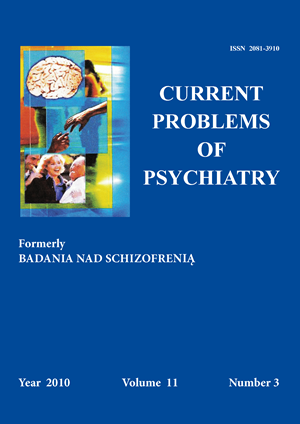Problemy kliniczne w terapii zaburzeń preferencji seksualnych – cześć pierwsza
Słowa kluczowe:
parafilia, farmakoterapia, psychoterapiaAbstrakt
Dewiacja seksualna (parafilia) jest to stan erotoseksualnej, powtarzającej się reaktywności lub obsesyjnej zależności od niezwykłego, nieakceptowanego bodźca zmysłowego lub istniejącego w fantazji, niezbędnego do uzyskania lub podtrzymania podniecenia seksualnego i/lub orgazmu. Zgodnie z kryteriami zawartymi w ICD-10, aby postawić pewne rozpoznanie zaburzeń preferencji seksualnych muszą być spełnione następujące warunki: 1. Osoba doświadcza powtarzającego się, nasilonego popędu i wyobrażeń seksualnych dotyczących niezwykłych przedmiotów lub działań, 2. Osoba zarówno realizuje ten popęd, jak i odczuwa z tego powodu wyraźne cierpienie, 3. Opisana preferencja występuje od co najmniej 6 miesięcy. Celem części pierwszej pracy jest charakterystyka wybranych parafilii (pedofilia, fetyszyzm, ekshibicjonizm, oglądactwo, tranzwestytyzm fetyszystyczny, sadyzm) oraz przybliżenie zagadnień związanych z obecnie dostępnym leczeniem biologicznym (farmakoterapią i leczeniem chirurgicznym). W części drugiej, autorzy przedstawili podstawowe zagadnienia związane z psychoterapią (indywidualną oraz grupową) zaburzeń preferencji seksualnych.
Bibliografia
1. Hill A., Habermann N., Berner W., Briken P. Psychiatric disorders in single and multiple sexual murderers. Psychopathology, 2007; 40: 22-28.
2. Bhugra D., Popelyuk D., McMullen I. Paraphilias across cultures: contexts and controversies. J. Sex. Res., 2010; 47(2): 242-256.
3. Międzynarodowa Statystyczna Klasyfikacja Chorób i Problemów Zdrowotnych. Rewizja dziesiąta. Rozdział V: Zaburzenia psychiczne i zachowania. Kraków; Uniwersyteckie Wydawnictwo Medyczne „Vesalius”: 1994.
4. Kafka M.P., Hennen J. A DSM-IV Axis I comorbidity study of males (n = 120) with paraphilias and paraphilia-related disorders. Sexual Abuse: J. Res. Treatm., 2002; 14: 349-366.
5. Långström N., Hanson R.K. High rates of sexual behavior in the general population: correlates and predictors. Arch. Sex. Behav., 2006; 35(1): 37-52.
6. Federoff J.P., Fishell A., Fedoroff B. A case series of women evaluated for paraphilic sexual disorders. Can. J. Hum. Sex., 1999; 8(2): 127-140.
7. Långström N., Seto M.C. Exhibitionistic and voyeuristic behavior in a Swedish National Population Survey. Arch. Sex. Behav, 2006; 35: 427-435.
8. Federoff J.P. Sadism, sadomasochism, sex, and violence. C. J. Psychiatr., 2008; 53(10): 637-646.
9. Blanchard R., Lykins A.D., Wherrett D., Kuban M.E., Cantor J.M., Blak T., Dickey R., Klassen P.E. Pedophilia, hebephilia and the DSM-V. Arch. Sex. Behav., 2009; 38: 335-350.
10. James W. Two hypotheses on the causes of male homosexuality and paedophilia. J. Biosoc. Sci, 2006; 38: 745-761.
11. Cohen L.J., Galynker I.I. Clinical features of pedophilia and implications for treatment. J. Psychiatr. Pract., 2002; 8(5): 276-289.
12. Edwards D. Mental Health's cold shoulder treatment of pedophilia. Behav. Heal. Manag., 2004; 24(3): 32-35.
13. Fagan P.J., Wise T.N., Schmidt C.W., Berlin F.S. Pedophilia. JAMA, 2002; 288: 2458-2465.
14. Sartorius A., Ruf M., Kief C., Demirakca T., Bailer J., Ende G., Henn F.A., Meyer-Lindenberg A., Dressing H. Abnormal amygdala activation profile in pedophilia. Eur. Arch. Psychiatry Clin. Neurosci., 2008; 258: 271–277.
15. Dickey R., Nussbaum D., Chevolleau K., Davidson H. Age as a differential characteristic of rapists, pedophiles, and sexual sadists. J. Sex. Marital. Ther., 2002; 28(3): 211-218.
16. Hall R., Richard C., Hall W. A profile of pedophilia: definition, characteristics of offenders, recidivism, treatment outcomes, and forensic issues. Mayo Clinic Proceedings, 2007(82): 457-471.
17. Reiersol O., Skeid S. The ICD diagnoses of fetishism and sadomasochism. J Homosex., 2006; 50(2/3): 243-262.
18. Kafka M. The DSM diagnostic criteria for fetishism. Arch. Sex. Behav., 2010; 39(2): 357-362.
19. Långström N. The DSM diagnostic criteria for exhibitionism, voyeurism, and frotteurism. Arch. Sex. Behav., 2010; 39(2): 317-324.
20. Bader S.M., Schoeneman-Morris K.A., Scalora M.J., Casady T.K. Exhibitionism: findings from a midwestern police contact sample. Int. J. Offender Ther. Comp. Criminol., 2008; 52(3): 270-279.
21. Rye B.J., Meaney G.J. Voyeurism: it is good as long as we do not get caught. Int. J. Sex. Health, 2007; 19: 1
22. Lev A.I. Disordering gender identity: gender identity disorder in the DSM-IV-TR. J.Psychol. Hum. Sex., 2005; 1: 35.
23. Blanchard R. The DSM diagnostic criteria for transvestic fetishism. Arch. Sex. Behav., 2010; 39(2): 363-372.
24. Fedoroff J.P. Sadism, sadomasochism, sex, and violence. Can. J. Psychiatry, 2008; 53(10): 637-646.
25. Doren D., Elwood R. The diagnostic reliability of sexual sadism. Sex Abuse, 2009; 21(3): 251-261.
26. Krueger R.B. The DSM diagnostic criteria for sexual sadism. Arch. Sex. Behav., 2010; 39(2): 325-345.
27. Repique R.J. Assessment & treatment of persons with pedophilia. J. Psychosoc. Nurs. Ment. Health Serv., 1999; 37(12):19-23.
28. Rufer M., Fricke S., Moritz S., Kloss M., Hand I. Symptom dimensions in obsessive-compulsive disorder: prediction of cognitive-behavior therapy outcome. Acta Psychiatr. Scand., 2006; 113(5): 440-446.
29. Jasiński M. Psychoterapia osób z zaburzeniami seksualnymi. W: Grzesiuk L. red., Psychoterapia. Warszawa; Eneteia: 2006. s. 491-505.


